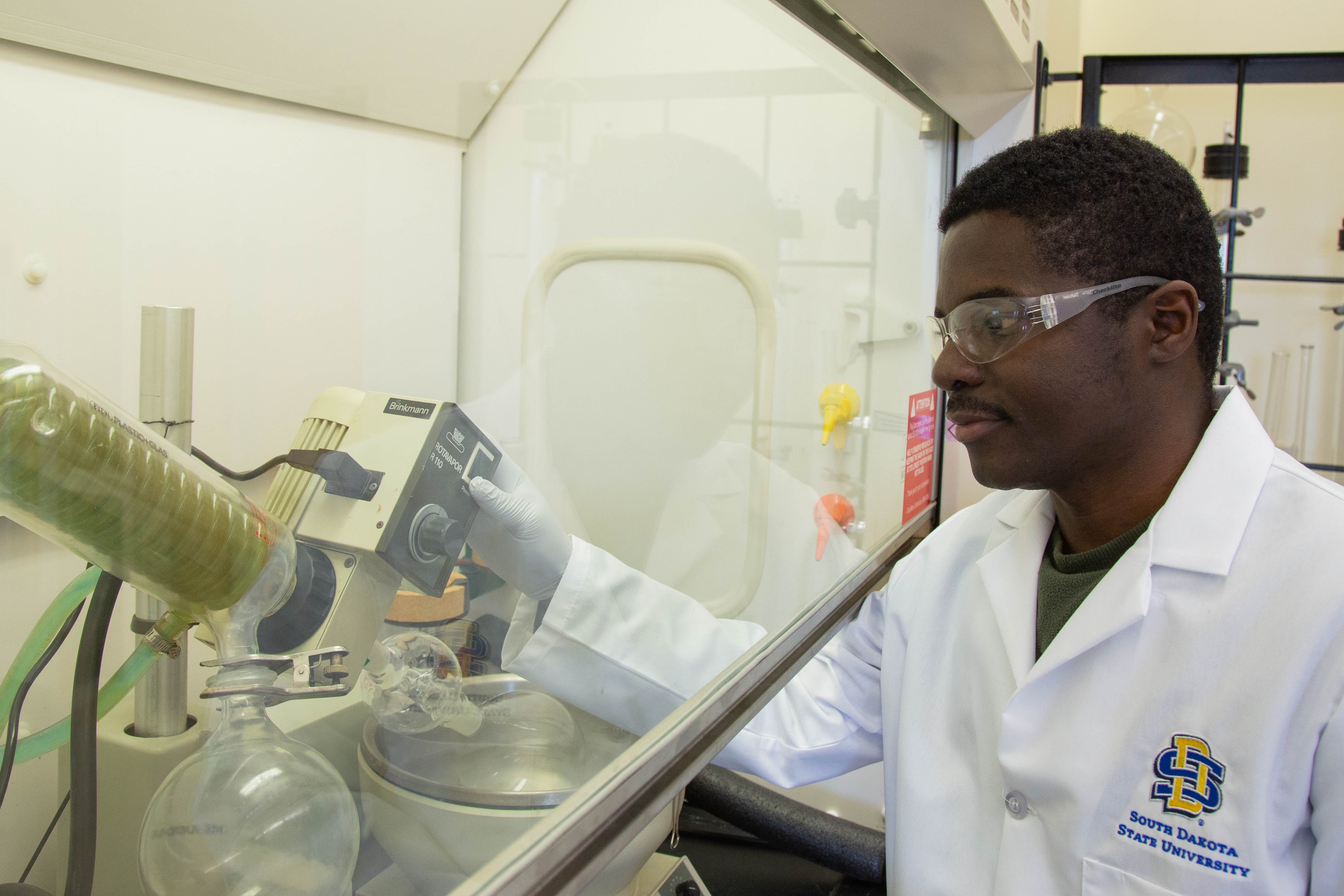Potentially harmful man-made chemicals used in firefighting foam and consumer products have contaminated groundwater and even private wells near military, industrial and disposal sites across the country—including Joe Foss Field and Ellsworth Air Force Base in South Dakota.
Currently, scientists must take water and soil samples from the sites to the lab and use expensive instruments to detect the presence of per- and polyfluoroalkyl substances, known as PFAS, said South Dakota State University chemistry and biochemistry professor Brian Logue. “There currently is not a good way to take that technology to the field.”
Logue and research scientist Randy Jackson of Seacoast Science, Inc. are developing a portable device to detect the presence of PFAS in water, sediment and soil through a two-year, $300,000 Phase II Small Business Innovation and Research grant from the Environmental Protection Agency. This is part of the agency’s efforts to help states and communities identify and address PFAS contamination and thereby protect the nation’s drinking water.
PFAS are a family of more than 3,000 chemicals used to make water- and stain-resistant fabrics, carpets and clothing as well nonstick cookware. They are in paints, cleaning products, some food packaging and firefighting agents. Some are also present in coatings for electronic components and solar panels as well as in medical devices.
The researchers are expanding the technology they developed for a portable cyanide detection device. That project was part of Jackson’s doctoral work, which he completed under Logue’s tutelage.
PFAS contamination
PFAS have been called “forever chemicals” because they are very stable—they persist both in the environment and in the human body.
“For most organic compounds, there are bacteria or oxidative or hydrologic chemical reactions that degrade them into less toxic compounds. However, PFAS are very difficult to degrade, so they stick around for a long time unless you actively try to degrade them,” Logue said.
“They are engineered to break down slowly with a half-life in water of more than 92 years,” Jackson said. “Their high water solubility makes them especially dangerous … they can enter and be transported by ground water into the drinking water supply.”
Ellsworth Air Force base near Rapid City is one of the EPA’s Superfund cleanup sites, due to PFAS contamination from the foam used to extinguish aircraft fires. In 2017, the U.S. Air Force reported that PFAS groundwater contamination had spread beyond the base into local private drinking water wells.
Last June, the City of Sioux Falls filed suit in U.S. District Court against a number of chemical companies, including 3M and DuPont, because PFAS have contaminated surface and groundwater, soil and sediment in the portion of Joe Foss Field leased to the South Dakota Air National Guard.
Human exposure can occur through contaminated water, soil and air. In 2007, the Centers for Disease Control and Prevention, which monitors human exposure to environmental chemicals, found 98% of Americans have detectable levels of PFAS in their blood. The substances also accumulate in the liver and kidneys.
Scientists have just begun studying their impact on human health; however, changes in liver, thyroid and pancreas function and hormone levels occur in animals exposed to high level of PFAS, according to the Agency for Toxic Substances and Disease Registry.
Developing PFAS detector
In Phase I, which was completed last year, the researchers showed they can measure/detect PFAS in water. “We came up with the idea to degrade PFAS to smaller components that are not as difficult to analyze, then isolate them and detect them fluorometrically like we detect cyanide in our lab,” Logue explained. However, he noted, though the concept is similar, “all the details are quite a bit different.”
Degrading the PFAS into smaller components is relatively easy, but selectively isolating these components from the matrix is challenging, he explained. Furthermore, the researchers had to synthesize chemicals that would react, or fluoresce, in the presence of the smaller components.
“We found a good fluorometric agent in Phase I, did some degradations and got some good results,” Logue said. Two doctoral students are also working on the project. During Phase II, the researchers will put the proof of concept into practice. “Now it is time to take the core technology and create a sensor to do this analysis,” he added.
This will involve optimizing the process, determining exactly which chemistry to use and the time required to detect PFAS. “We’ve focused so far on water, which is the easiest matrix,” Logue said. “Once the sensor works well with water, there are ways to prepare soil samples to use that same technology.”
Based on the near real-time analysis, the scientists will then know whether the site warrants further assessment. In addition, Logue sees the possibility of further applications for the sensor because industries use similar compounds.
About Seacoast Science, Inc.
Seacoast Science, Inc, is a high technology company focused on the next generation of chemical sensor and chemical detection devices. Its emphasis is on the development of gas sensors for a variety of markets including leak detection, military, homeland security, air quality monitoring, and emission gas detection.
Original post https://alertarticles.info
